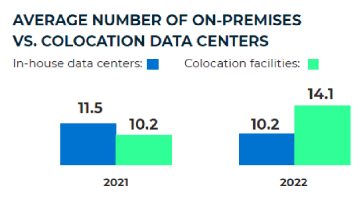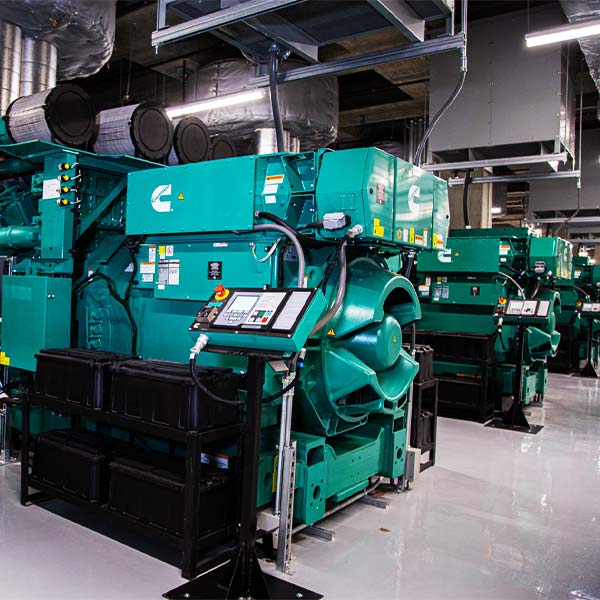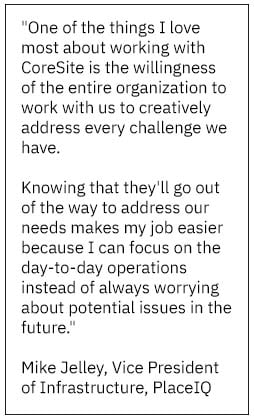
Understanding Data Center Customer and Provider Responsibilities
Increasingly, companies (network providers, cloud providers and enterprises) are moving from on-premises data centers to colocation. Why? In this post, we discuss the relationship between data center colocation providers and customers.
Among the drivers of this trend are:
- Cost reduction
- Centralization of IT operations
- Ensured reliable operating environments including proper and uninterrupted power and cooling
- Enhanced security
- High performance connectivity and interconnections with other businesses
- Future-proofing businesses by supporting on-demand scalability and 24/7/365 availability
- Assured business continuity

Different customers have different understandings and expectations of what their experiences will be when they colocate their computing hardware and servers in a data center. Some have very little experience with data centers and expect that once they’ve moved their equipment in, the data center staff will manage everything else going forward. More experienced customers understand that colocation data centers provide specific services and are responsible for explicit tasks in the data center facility.
Understanding Respective Responsibilities
Data center colocation isn’t about just outsourcing some operational and maintenance tasks to a third party. Rather, it is a partnership in which both the customer and the data center have well-defined responsibilities.
So, as you think through the decision to migrate some or all of your IT infrastructure to a colocation facility, keep in mind that won’t mean you’ll no longer have maintenance and operational responsibilities for your assets.
Data Center Responsibilities
The colocation supplier’s responsibilities start with providing a facility that offers space with the proper power, cooling and security to host your computing hardware and servers. This capacity can include anything from single racks to cabinets and cages to private suites. Some CoreSite customers occupy an entire floor or more of a facility. The specifics of each colocation installation and requirements are spelled out in a master contract that also details what the client can expect from the data center. If a customer wants the data center to perform additional services, that can be settled through a customized contractual arrangement.
CoreSite Remote Hands Support offers customers a variety of additional services that can relieve customers of a multitude of emergency and routine technical tasks. By partially outsourcing the installation, operation and management of your deployment to expert technicians within a CoreSite facility, you can focus on other core elements that are critical to running your business.
In addition to providing a highly secure facility for housing customer IT equipment, a data center colocation provider is responsible for the monitoring and maintenance of all of the systems that are not part of clients’ data center deployment.
At CoreSite data center facilities, these responsibilities fall into four basic categories:
- Preventative Maintenance (PVM) includes all inspections, operations and preservation efforts designed to avoid, detect, or mitigate the deterioration of a component or system. The aim is to sustain the operation or life expectancy of the components and systems within the CoreSite infrastructure.
- Predictive Maintenance (PDM) includes all inspections, measurements and trending indicators intended to benchmark and track changes in the condition of the CoreSite infrastructure over time in an effort to anticipate failures before they occur.
- Corrective Maintenance (CM) includes activities performed in response to improper or sub-par operation of components or systems that will not necessarily result in imminent failure.
- Emergency Maintenance (EM) includes activities performed in response to improper operation of a critical component or system that has failed or is in danger of imminent failure.

Examples of Data Center Maintenance
Different assets in any data center require maintenance on a documented schedule (annually, semi-annually, monthly, weekly). For example, the following are several descriptions of maintenance that is performed at CoreSite data centers:
- Generators are exercised without load every 30 days or as required. Outside conditions such as pending severe weather or planned power interruptions may justify a generator run prior to such events to ensure generator integrity.
- Generators must be able to be placed back in service within 15 minutes in the event of a utility outage. To ensure that capability, generator batteries, which supply power in the event of an outage, are replaced every two years.
- Predictive maintenance using thermal scanning is performed on all UPS components on an annual basis.
- The operation of HVAC equipment including air handling units, computer room air conditioners, computer room air handlers, variable frequency drives, fan coil units, fan units and condensing units is inspected quarterly.
- Fire protection equipment is tested according to municipal requirements to ensure the equipment is in proper operating condition according to proper installation and in accordance with generally accepted practice and the code in effect at the time of the installation.
- Monthly inspection of fire extinguishers and the fire suppression system plus annual inspection of fire extinguishers and tagging or extinguishers with inspection tags.
Customer Responsibilities
Once customers’ IT assets are installed, the configuration, performance and monitoring of their systems, applications and connectivity falls to them, unless they’ve contracted for specific services through CoreSite’s Remote Hands Support.
For instance, it’s important for customers to keep their space free of cardboard to ensure that cardboard dust doesn’t interfere with the operation of their equipment or cause trouble with ventilation systems.
Customers also need to observe data center protocols. Two common cautions are to not bring food or drink into the data center to avoid accidental mishaps that could cause equipment damage or outages, and to not wear open-toed shoes for safety reasons. We also follow security good practices, for example “no tailgating,” which means making sure that each person swipes their badge as through go through a door, even if in a group.
CoreSite’s data center technicians make it a point to not enter customer spaces, although at the outset they may assist customers by showing them the best way to rack and stack their equipment and properly connect to the primary and secondary power whips.

While the data center may provide visual security systems to monitor the entire facility, if a customer wants to have extra cameras in their own operational spaces, the procurement, installation and monitoring of those are the customer’s responsibilities.
Customers should also plan on making periodic visits to their colocation sites to make sure nothing’s changed in their environments, that equipment is operating within expected parameters, to assess whether upgrades or other changes may be needed and to determine a timeframe for maintenance.
Ensuring a Smooth Transition into the Data Center
Because each customer’s requirements are unique, it’s important to begin the data center migration with a clear understanding of the installation process and roles and responsibilities. That’s where our kick-off call comes in.
Data center staff may be asked by a customer to assist in the design of its data center deployment. The timeline of the deployment should also be discussed. Beyond that, customers may have questions about the data center specific to their installations regarding power systems and configurations, HVAC systems, fire suppression systems, security systems, general building protocols, invoicing procedures and other particulars.
Both general types of questions and more granular, customer-specific questions can be effectively addressed in kick-off calls between a customer and the data center client service staff prior to a customer moving into the data center. The kick-off call should be considered a high priority in order to make the transition into the data center as smooth as possible. In addition to covering the questions mentioned above, a CoreSite kick-off call can include a demonstration of CoreSite’s Service Delivery Platform and best practice suggestions on how to leverage colocation to achieve the most effective results. The sooner clients can be onboarded, the sooner they can get on with running their businesses.
After the kick-off call, ongoing communication between clients and CoreSite’s Client Services Team further ensures successful, smooth-running colocation deployments.
Contact CoreSite to learn more about the details on deployment and how colocation can help make your organization more efficient, agile and profitable.










